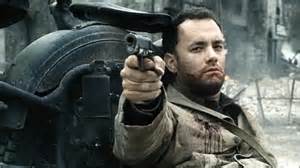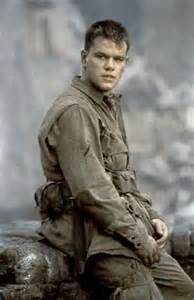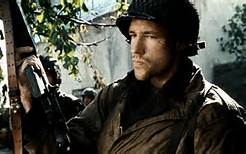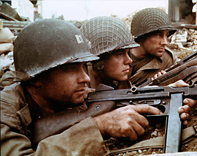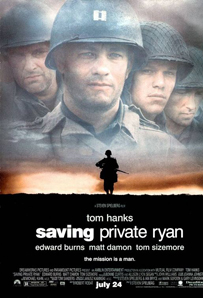 The cast of Saving Private Ryan is dynamic! From leading roles, to supporting roles to cameo appearances from actors such as Ted Danson who plays Captain Fred Hamill and Paul Giamatti as Staff Sergeant William Hill this film is full of actors who bring many different styles to help tell this story.
The cast of Saving Private Ryan is dynamic! From leading roles, to supporting roles to cameo appearances from actors such as Ted Danson who plays Captain Fred Hamill and Paul Giamatti as Staff Sergeant William Hill this film is full of actors who bring many different styles to help tell this story.
For this blog entry, I’ll discuss the acting styles of three specific actors, Tom Hanks, Matt Damon and Edward Burns.
Thom Hanks:
Thom Hanks is a definitely a star actor that draws attention to any film he works in. As far as acting style, he is more of a wild-card or character actor, especially when you compare the diverse roles he’s played. Consider Bachelor Party; Forest Gump; The Da Vinci Code; Castaway: The Green Mile: and list goes on. Thom Hanks can adapt to a comedian as in Bachelor Party, to a social outcast as in Forest Gump, to serious roles as with The Green Mile or Saving Private Ryan. Actors such as Hanks are “…able to fit invisibly into a wide variety of disparate characters, adapting to the needs of each script and director they work with, known as character actors.” (Goodykoontz, Jacobs, 2014).
Matt Damon:
Matt Damon is another character actor who hasn’t really been typecast into any one role or type of role. Although he recently has been cast in more action hero type roles after the his role as Jason Bourne. He has also become a star like Thom Hanks and also draws the attention of audiences in what ever role he plays. Matt Damon had played action hero’s; a thief, as well as serious roles and has the ability to work outside specific roles like other typecast actors.
Edward Burns:
Edward Burns is more of a personality actor. Although he has played several different roles in movies such as The Brothers McMullen, She’s the One, and Sidewalks of New York, Edward Burns’ characters are all very similar. He is usually cast as a typical guy from the Bronx who is quick on sarcasm. Even as Private First Class Richard Reiben, he is a cocky kid from the Bronx who says what’s on his mind.
Of these three actors, who are all outstanding, Thom Hanks and Matt Damon are less likely to be typecast into anyone specific style or role. Edward Burns, although talented, I believe will continue to play the cocky New Yorker regardless of the role he plays…which works because that is the character audiences expect from him.
References:
Goodykoontz, B., & Jacobs, C. P. (2014). Film: From watching to seeing (2nd ed.). San Diego, CA: Bridgepoint Education, Inc
